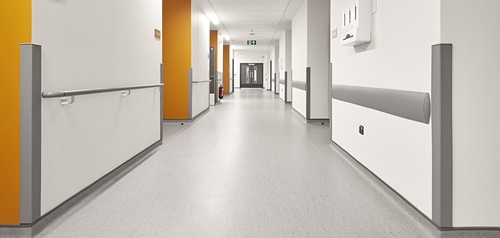Wall Guards vs Corner Guards: What’s the Difference?
9th Jul 2025
Wall Protection Guide: Choosing Between Wall Guards and Corner Guards
When it comes to protecting your interior walls from impact, scuffs, and long-term wear, two popular solutions stand out: wall guards and corner guards. But what’s the difference between them—and how do you know which one your building needs?

In this guide, we break down the key differences between wall guards (also called crash rails or bumper bars) and corner guards (also known as wall corner protectors), so you can make the best decision for your space.
What Are Wall Guards?
Wall guards are protective rails mounted along flat wall sections, typically at chair-rail height or higher. They’re designed to absorb impact from trolleys, hospital beds, wheelchairs, carts, and daily foot traffic. You’ll often see them in hospitals, schools, and public corridors where wall surfaces are constantly exposed to movement and potential damage.
Key Features:
- Mounted horizontally along walls
- Available in PVC, rubber, stainless steel, and aluminium
- Often used in hospitals, hallways, and public spaces
- Helps prevent scratches, dents, and impact damage
Browse our full range of wall guards and wall protection systems.
What Are Corner Guards?
Corner guards, also known as wall corner protectors or corner protectors for walls, are designed to cover and protect vulnerable wall edges. These are the spots most prone to chipping and cracking—especially in high-traffic environments like hospitals, warehouses, and schools.
Key Features:
- Mounted vertically on external wall corners
- Available in materials like PVC-u, stainless steel, rubber, and aluminium
- Protects against knocks from carts, equipment, and foot traffic
- Ideal for healthcare, education, retail, and industrial settings
Explore our complete Corner Guards collection.
Wall Guards vs. Corner Guards: What’s the Difference?
| Feature | Wall Guards | Corner Guards |
|---|---|---|
| Primary Function | Protect flat wall surfaces | Protect exposed wall edges/corners |
| Installation Orientation | Horizontal | Vertical |
| Materials Available | PVC, aluminium, rubber, stainless steel | PVC, aluminium, rubber, stainless steel |
| Ideal Use Cases | Corridors, healthcare, commercial interiors | Hospitals, schools, warehouses, retail corners |
| Damage Prevention | Scuffs, scrapes, impacts from moving equipment | Chips, cracks, edge damage from collisions |
Can You Use Both?
Yes! In fact, using both wall guards and corner guards provides the most comprehensive protection for your building. Wall guards prevent surface damage along long corridors, while corner guards shield vulnerable angles and edges from impact damage. Together, they keep your interiors looking clean and professional—and cut down on ongoing maintenance costs.
How to Choose the Right Material
The material you choose will depend on your environment, budget, and desired finish:
- PVC – Cost-effective and easy to clean
- Stainless Steel – Hygienic, durable, and modern-looking (popular in healthcare)
- Rubber – Shock-absorbing and industrial-grade
- Aluminium – Lightweight, durable, and corrosion-resistant
Need Help Selecting the Right Wall Protection?
Whether you’re working on a healthcare facility, school renovation, or commercial office fit-out, we can help you find the right wall and corner protection products for your project. Contact us for advice, volume pricing, or technical specifications.
Ready to order? Start by browsing our full range of Wall Protection and Corner Guards.
